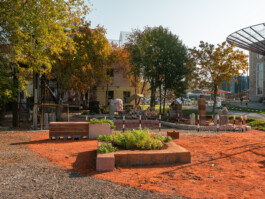















SCULPTURE GARDEN
Material lab, landscaping, engagement events, planning consultation
Contemporary Art Museum of Estonia (EKKM), Tallinn, Estonia
2021
The garden is situated at the legalised premises of an ex-squat, now established as a non-profit initiative called the Contemporary Art Museum of Estonia. Tallinn Council neglectfully demolished garages on the edge of the site, leaving behind bare open land. That action unintentionally turned the previously enclosed museum courtyard into a fully open outdoor space, albeit as a lousy crushed asphalt field on the interface between the museum and the public.
We proposed a simple spatial solution to create a public sculpture garden for the museum that could last for up to 5 years, directed available resource – materials, finances, labour - into planning and building it, assisted the museum in applying for grants and cooperated with the Estonian Association of Architects to plug their ongoing installation competition into the museum’s garden project, i.e. united two low-budget initiatives into one joint project.
In collaboration with a local rammed earth company Saviukumaja we delivered the playable outdoor installations that simultaneously function as a material laboratory for outdoor uses of rammed earth, where the material can be tested in public space uses and in harsh weather conditions of rain, wind and temperatures below -20°C degrees. The figures were built during public workshops and includes a variation of stabilised or unstabilised rammed earth mixes, joinery details and reclaimed concrete leftovers. Rigorous planning and archiving of the process in order to survey the material in public space use and weather conditions over time.
The garden is made up of large curvy planting beds surrounded by reclaimed brick edges and sculpture bases within them. The plants are reclaimed from the council’s parks management team and personal gardens of community members. The project aims to generally improve the functioning of the public realm around the museum and also includes a large entrance terrace on the other side of the museum building, a light fence wiggling through and around the planting beds, simultaneously creating a boundary to the community garden in the far corner of the site. The light touch improvements are ongoing and this year will focus on the needs of the community gardeners.
The success of the project is not merely entailed in its finished outcome but also in the process during which several low budget initiatives were joined up, neighbouring institutions mobilised and worked together to better their surroundings, as well as in the series of workshops that brought together clay construction enthusiasts, architects, local residents, art and design students. The construction materials were sourced sustainably –from the second hand market, from large producers’ waste and residual materials or simply from companies who work with sustainable materials and methods like clay. Rather than an afterthought, these materials directly inspired and informed the design from the outset.
The project both benefitted from the invested community input as well as helped to establish and tighten it. The project is continuous, accelerating when resources become available. There is a sense of shared responsibility and ownership over the spaces due to how the process unfolded.
Client and event production: Estonian Association of Architects
Site production and collaborator: Contemporary Art Museum of Estonia
Rammed earth experts: Saviukumaja
Lectures by: kuidas.works, Juss Heinsalu
Planting: Park of Kadriorg (Tallinn City Council) & EKKM community garden
Featured in: 2022 Oslo Architecture Triennale Neighborhood Index